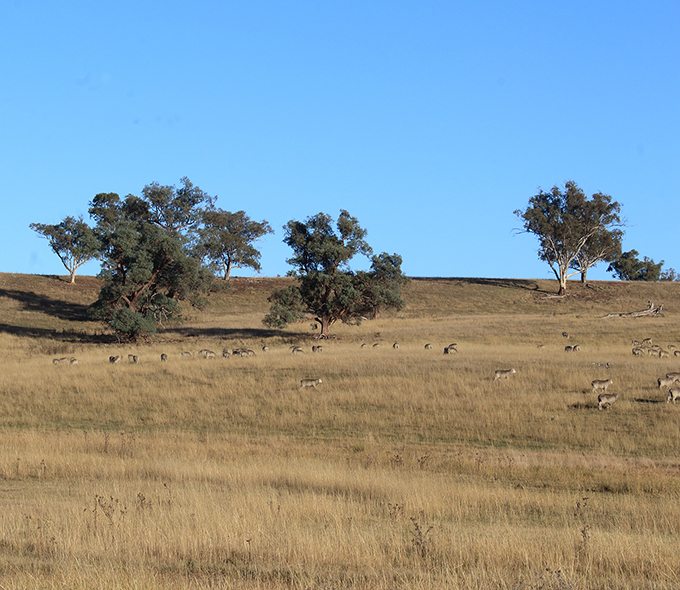Less than 10% of our original inland temperate grassy woodlands remain in New South Wales. Isolated paddock trees and small patches of trees represent 40% of the remaining woodland cover. These highly cleared grassy woodland communities contain eucalypts including white box, yellow box, grey box, red box, apples box, fuzzy box and Blakely's red gum.
Importance of scattered trees
Hundreds of species of animals, including invertebrates, depend on scattered trees in rural landscapes for their survival. Research has shown that large, old, scattered trees support more native birds and bats than younger trees in a woodland setting. The animals benefit from the different habitats in the cracks and hollows that form as the trees age.
Larger trees produce more food resources for fauna, including nectar, pollen, fruit and seeds.
Dead trees in rural landscapes also provide key habitat for many animals and should be retained.
Benefits of scattered trees
Scattered trees:
- provide shelter for pastures, crops, and stock from wind, heat, and cold
- help reduce salinity by developing large roots and pumping sub-surface water, lowering the water table and reducing the risk of salt reaching the surface
- provide habitat for mammals, birds, lizards and frogs that feed on pest insects; for example, honeyeaters can consume 24 to 36 kg of insects per hectare per year, while one insect-eating bat can eat up to 600 flying insects in an hour
- reduce erosion and improve water quality – tree roots reduce erosion, especially in gullies and along creek banks, and tree debris filters unwanted nutrients and silt from runoff into creeks
- provide habitat for threatened species such as the superb parrot, regent honeyeater, bush stone-curlew, and squirrel glider
- increase nutrient cycling – tree roots reach nutrients deep in the soil, and fallen tree debris reintroduces these nutrients to the topsoil
- encourage the growth of understorey native vegetation that attracts insect-eating birds and can be used as fodder
- provide important seed sources that can be used for future propagation for woodland restoration
- provide important visual aesthetics in rural landscapes.
Why scattered trees are declining
Isolated and small patches of trees are rapidly declining due to:
- ongoing loss from land clearing
- natural disasters such as storms and floods
- natural ageing and death
- dieback, that can be caused by prolonged drought, salinity, and soil pathogens such as root rot fungus Phytophthora cinnamomi
- low rates of regeneration, resulting in lack of replacement
- stubble burning and firewood collection.
Research indicates that many more of our precious scattered trees could disappear from southeast Australia within the next 50 years if we do not significantly reduce these threats.
Protecting scattered trees
To protect scattered trees:
- restrict livestock access to critical times only
- protect trees by fencing or using other barriers to stop stock damage
- allow tree debris to remain on the ground next to trees, including timber, rocks, logs, and stumps, to provide habitat for birds, bats, lizards, and other native fauna
- avoid fertiliser application and cultivation near the trees
- control the spread of weeds
- avoid herbicide drift onto the trees
- ensure adequate fire breaks around the trees during stubble burning.
To help native trees regenerate, build a fence around them until seedlings are at least 2 metres tall. TThe fence needs to placed outside of the shade or ‘dripline’ of the canopy, otherwise the seedlings will struggle to grow.
Large trees can be used as the focal points for landscape connectivity restoration planting – stepping stones of dense shrubs can be planted between mature trees to allow movement of small birds across open areas.
